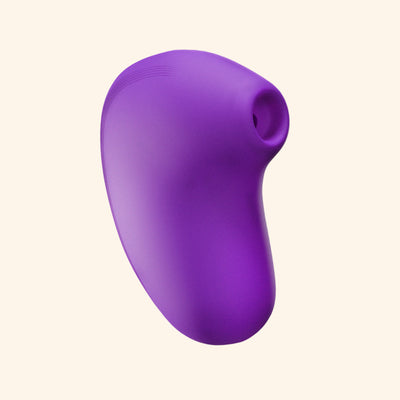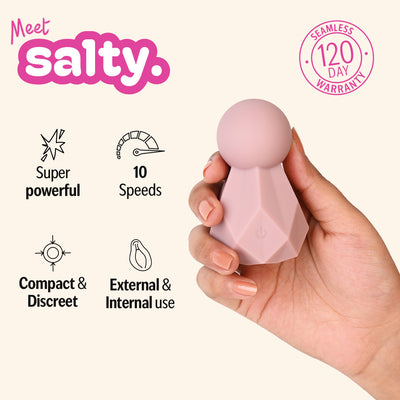Your cart is currently empty

For many, the bedroom is a stage where performances aren’t always Oscar-worthy, but they certainly deserve an award for effort. Faking orgasms — a phenomenon quite common — often serves as a misguided shortcut to satisfy partners or to end sexual encounters that aren't fulfilling. But let’s face it: while orgasms shouldn't be the end goal, pleasure should be, and faking it doesn't help anyone in the long run. So how do you break the cycle? Let’s explore how you can stop faking orgasms and start enjoying more genuine sexual experiences.
Firstly, it's important to understand the reasons behind why people fake orgasms. For some, it's about pleasing their partner, thinking that showing satisfaction will boost the other's ego. For others, it might stem from concerns about their ability to reach orgasm or worries that their needs are too complex or time-consuming to be met. Identifying the root cause of why you might be putting on a performance is the first step to making positive changes.

A friend of mine used to tell me about how she would fake orgasms during sex. She joked that she had a routine down, complete with all the right noises and movements, almost like she was putting on a show. But one day, after pretending yet again, she lay back and realised she felt more like an actor than a participant.
Feeling fed up, my friend decided it was time for a change. The next time she was with her partner, she gathered her courage and honestly shared what she liked and didn’t like. It was a bit scary to be so open, but it completely changed their relationship. They started learning and exploring together, making their connection more genuine. It doesn't sound that simple, but it definitely sounds doable!
The orgasm gap
When it comes to bedroom dynamics, there's an elephant in the room we can't ignore: the orgasm gap. This glaring disparity between the sexes in achieving sexual climax is more than just frustrating—it's a significant commentary on the state of sexual satisfaction. A 2021 survey by Tinder reveals that 50% of Indian women admit to faking orgasms, it’s likely that the actual figures might be even higher. This statistic isn't just a number; it's a reflection of unmet needs and a call to action for more effort and understanding from partners, predominantly men. Why are so many women putting on a performance?

A set of studies published in the Society for Personality and Social Psychology concluded that “women who perceive that their partners’ manhood is precarious (i.e., easily threatened) censor their sexual communication to avoid further threatening their partners’ masculinity.” It even revealed that women who were earning more than their male partners, were more likely to fake an orgasm! Which means, when women sense their partner’s masculinity is being challenged, they struggle to communicate their sexual needs.
Women might fake pleasure not only to boost their partner's ego but also to end a sexual encounter that isn't going anywhere near their satisfaction. It’s like putting a band-aid on a broken leg—it might cover the issue, but it certainly doesn’t fix the problem.
One of the most straightforward ways to stop faking orgasms is to start communicating more openly with your partner. This might sound daunting if you're not used to discussing your sexual needs, but it's a critical step towards more satisfying experiences. Initiate a conversation outside the bedroom where you can discuss your feelings without the immediate pressure of sex. Remember, vulnerability in communication can significantly deepen your connection and improve your sexual experiences. If the conversation feels awkward, you might start with sentences like, “I’ve been thinking about how we can make our sex life even better…” or “I’d love for us to explore different ways to really enhance our pleasure.”
Men fake it too!
It’s a common myth that only women fake orgasms, but let me set the record straight: guys are in on this act too, even if the number of women who do it is way high. A study from the University of Kansas sheds some light on this, revealing that many men fake it because they want sex to end or realise an orgasm just isn’t in the cards—maybe they’re a bit too tipsy, a tad bored, or medication is throwing them off their game.
Honestly, it kind of makes sense. If you’re all wrapped up (safety first, right?), and you're not exactly feeling the grand finale vibe, faking it can seem like the easiest way to wrap things up without making a scene.
Now when it's clear that people irrespective of their gender or sexual orientation can fake Os, how do we stop doing that? I want you to first recognize that you're not alone in this, and it’s great that you're ready to make a change. Faking orgasms is a bit like putting on a one-person show night after night. It's exhausting, isn’t it? And at the end of the day, it might earn you applause, but not satisfaction.
Psychologically, when you fake it, you're playing into the narrative that your partner's pleasure or ego is more important than your own authentic experience. This can lead to a cycle where your own needs and desires become sidelined, and sex starts to feel more like a performance than an intimate, mutual exchange.
Here’s the turnaround you’re looking for: Start by turning the spotlight inward. Spend some solo time discovering what truly brings you pleasure. Understanding your body’s likes and dislikes outside a partner dynamic can bolster your confidence in expressing your needs.
Toys and accessories can be game changers in the bedroom. Think about it: if you know exactly what brings you to climax and makes you feel fantastic, why would you settle for less? It's like choosing between a bland, forgettable meal and your favourite comfort food that never fails to satisfy. So it's important for you to experiment with your pleasure with the help of these things, so that you are aware what it is that you exactly like. This self-awareness can boost your confidence in expressing your needs to a partner.
Now, let's jazz up your approach to sex with a twist of sincerity. Start by fostering an environment where open communication is the norm, not the exception. This doesn’t have to be a big sit-down discussion right away. Ease into it by sharing what you enjoy in moments of closeness. Something as simple as, “I really like it when you...” can positively reinforce the actions that genuinely bring you pleasure. Begin with non confrontational conversations. Use the ‘I’ statements often. When discussing your needs, frame your sentences with 'I' to avoid making your partner feel defensive. For example, "I feel really turned on when..." or "I would love to try...". Likewise, be open to receiving feedback without taking it personally.
It's not just about the climax
Consider the broad spectrum of sexual pleasure—it's not just about the climax. Allow yourself to feel every touch, every kiss, without the pressure of the grand finale. Encourage your partner to explore with you, discovering together what makes each tick, hum, or even roar with pleasure! Extend foreplay to increase intimacy and connection. This is a great time to explore different types of touch and sensations that could enhance your overall experience. It is also very important that you both feel calm and relaxed during intimacy. Reduce performance pressure by creating a relaxed and inviting environment. Dim the lights, play some soft music, or light candles to make the space feel more intimate and less intimidating.

And if the topic feels too hefty to handle alone, that's what therapy’s for! Sometimes, a little guidance to untangle your feelings and fears is just what you need to get you both back on track. Therapy can provide a safe space to explore underlying issues and develop effective communication strategies.
Exploring Clitoral Sensitivity
Understanding clitoral sensitivity is a crucial aspect of female pleasure and sexual satisfaction. The clitoris, with its thousands of nerve endings, is often referred to as the epicenter of pleasure for people assigned female at birth. Its sensitivity varies from person to person, but regardless of the degree, it plays a pivotal role in sexual arousal and climax.
Many factors influence clitoral sensitivity, including hormonal fluctuations, arousal levels, and individual differences. During arousal, blood flow to the clitoral region increases, enhancing sensitivity and responsiveness to touch and stimulation. Understanding these fluctuations can help individuals navigate their sexual experiences with more awareness and intention.
To learn more read out blog on clitoral sensitivity
In the realm of self-pleasure and sexual exploration, vibrators stand as versatile tools capable of unlocking new dimensions of pleasure and satisfaction. While the stigma surrounding sex toys may still linger, more people are embracing these devices as empowering aids in their journey towards sexual fulfilment .
Remember, sex is supposed to be fun and fulfilling, not a scripted routine where you feel compelled to perform. By shifting your focus from performance to pleasure, you’re setting the stage for more genuine—and yes, more enjoyable—sexual experiences. Stopping the habit of faking orgasms opens up a path to more genuine and fulfilling sexual experiences. It requires honest communication, a bit of courage, and sometimes, a few good tools. Don’t shy away from using what’s available to enhance your experience. Our range of massagers and toys, for example, can add that extra spark and pleasure to your explorations. Remember, by being true to yourself and your partner, you’re setting the stage for not just better sex, but a deeper connection. So here’s to more honesty and more O’s — the real ones.
----------About the Author
Disha (she/her) believes she's half therapist because people spill their guts to her with ease. But for now, she's writing sassy pieces on the internet about all things fun and pop culture. With a flair for wit and a curious spirit, she is all about digging into the saucy details of human intimacy.











